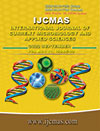


 National Academy of Agricultural Sciences (NAAS)
National Academy of Agricultural Sciences (NAAS)

|
PRINT ISSN : 2319-7692
Online ISSN : 2319-7706 Issues : 12 per year Publisher : Excellent Publishers Email : editorijcmas@gmail.com / submit@ijcmas.com Editor-in-chief: Dr.M.Prakash Index Copernicus ICV 2018: 95.39 NAAS RATING 2020: 5.38 |
A field experiment was conducted in agronomy farms at Department of Agronomy, Pandit Jawaharlal Nehru College of Agriculture and Research Institute, Karaikal during kharif season of 2019 to investigate the performance of different seed priming materials in ragi (TRY 1) for coastal deltaic regions of Karaikal. The crop was raised in Randomised Block Design (RBD) with nine treatments and replicated thrice. Ragi seeds were primed in different botanical extract and it was used for sowing. Primed seeds had generally shown higher germination percentage, deeper root system and early flowering than unprimed seeds. Seeds primed with three percent panchakavya had shown better growth attributes like plant height (109. 8 cm), LAI (4.64) and DMP (9965 kg ha-1) and yield attributes like number of productive tillers (4.1), weight of an ear head (7.75 g) and number of grains per ear head (1923). Grain yield of ragi was higher in panchakavya priming (1993 kg ha-1). However, certain priming treatments like pungam leaf extract, ocimum leaf extract and plain water was comparable with panchakavya priming. Lowest grain yield was obtained in control (1256 kg ha-1) Panchakavya priming had a higher B: C ratio of 2.37 with added returns of Rs. 18,078 ha-1.
 |
 |
 |
 |
 |